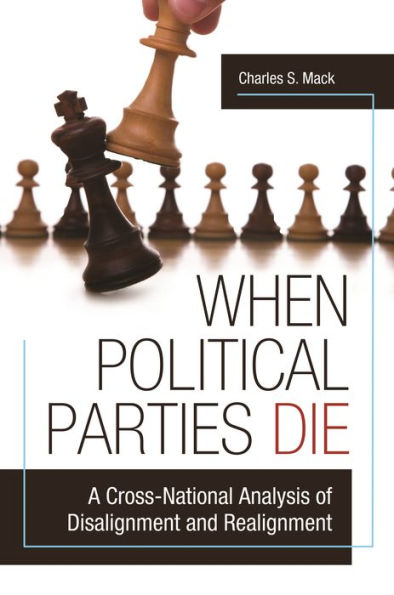This book presents a theory of political disalignment and a revised theory of party realignment, using four case studies from the United States, Canada, Great Britain, and Italy to illustrate these concepts.
Why do major political parties die? The shelf life of minor parties in democracies tends to be short, but major parties tend to be highly durable. The Democratic Party of the United States and the Conservative Party of the United Kingdom have been going strong for two centuries. Major parties perpetuate themselves by maintaining a consistent ideology on major national issues, even at the cost of periodic defeats at the polls. In American politics, ideological polarization maintains the vitality of the two major parties and renders them almost immune to threats from new parties, even as it impedes consensus and compromise on public issues.
Spectacular instances of sudden death in major parties have nevertheless occurred in the United States, the United Kingdom, Canada, and Italy, and they all exhibit similar characteristics. The fatal event—which author Charles S. Mack calls "disalignment"—occurs when a schism opens between party leaders and traditional core-base voters on an issue of overriding national importance. Major parties survive periodic defeats, but they cannot survive disalignment.
1100883698
Why do major political parties die? The shelf life of minor parties in democracies tends to be short, but major parties tend to be highly durable. The Democratic Party of the United States and the Conservative Party of the United Kingdom have been going strong for two centuries. Major parties perpetuate themselves by maintaining a consistent ideology on major national issues, even at the cost of periodic defeats at the polls. In American politics, ideological polarization maintains the vitality of the two major parties and renders them almost immune to threats from new parties, even as it impedes consensus and compromise on public issues.
Spectacular instances of sudden death in major parties have nevertheless occurred in the United States, the United Kingdom, Canada, and Italy, and they all exhibit similar characteristics. The fatal event—which author Charles S. Mack calls "disalignment"—occurs when a schism opens between party leaders and traditional core-base voters on an issue of overriding national importance. Major parties survive periodic defeats, but they cannot survive disalignment.
When Political Parties Die: A Cross-National Analysis of Disalignment and Realignment
This book presents a theory of political disalignment and a revised theory of party realignment, using four case studies from the United States, Canada, Great Britain, and Italy to illustrate these concepts.
Why do major political parties die? The shelf life of minor parties in democracies tends to be short, but major parties tend to be highly durable. The Democratic Party of the United States and the Conservative Party of the United Kingdom have been going strong for two centuries. Major parties perpetuate themselves by maintaining a consistent ideology on major national issues, even at the cost of periodic defeats at the polls. In American politics, ideological polarization maintains the vitality of the two major parties and renders them almost immune to threats from new parties, even as it impedes consensus and compromise on public issues.
Spectacular instances of sudden death in major parties have nevertheless occurred in the United States, the United Kingdom, Canada, and Italy, and they all exhibit similar characteristics. The fatal event—which author Charles S. Mack calls "disalignment"—occurs when a schism opens between party leaders and traditional core-base voters on an issue of overriding national importance. Major parties survive periodic defeats, but they cannot survive disalignment.
Why do major political parties die? The shelf life of minor parties in democracies tends to be short, but major parties tend to be highly durable. The Democratic Party of the United States and the Conservative Party of the United Kingdom have been going strong for two centuries. Major parties perpetuate themselves by maintaining a consistent ideology on major national issues, even at the cost of periodic defeats at the polls. In American politics, ideological polarization maintains the vitality of the two major parties and renders them almost immune to threats from new parties, even as it impedes consensus and compromise on public issues.
Spectacular instances of sudden death in major parties have nevertheless occurred in the United States, the United Kingdom, Canada, and Italy, and they all exhibit similar characteristics. The fatal event—which author Charles S. Mack calls "disalignment"—occurs when a schism opens between party leaders and traditional core-base voters on an issue of overriding national importance. Major parties survive periodic defeats, but they cannot survive disalignment.
67.5
In Stock
5
1

When Political Parties Die: A Cross-National Analysis of Disalignment and Realignment
344
When Political Parties Die: A Cross-National Analysis of Disalignment and Realignment
344Related collections and offers
67.5
In Stock

Product Details
| ISBN-13: | 9798216164524 |
|---|---|
| Publisher: | Bloomsbury Publishing |
| Publication date: | 08/11/2010 |
| Sold by: | Barnes & Noble |
| Format: | eBook |
| Pages: | 344 |
| File size: | 1 MB |
| Age Range: | 7 - 17 Years |
About the Author
What People are Saying About This
From the B&N Reads Blog
